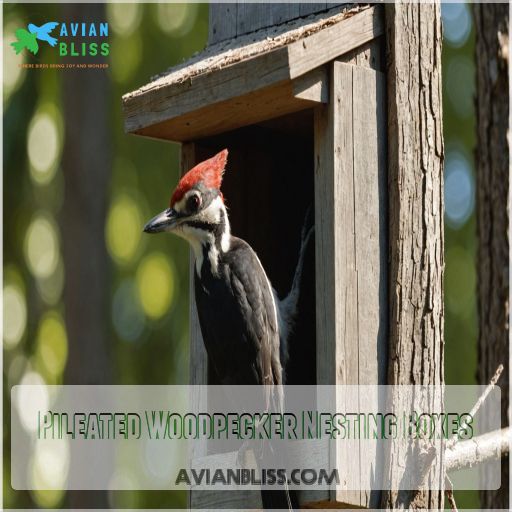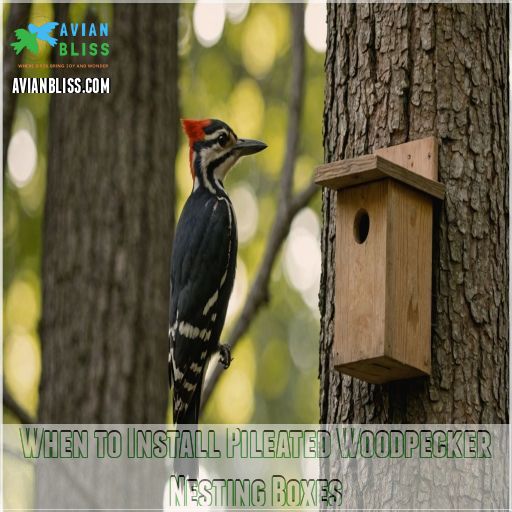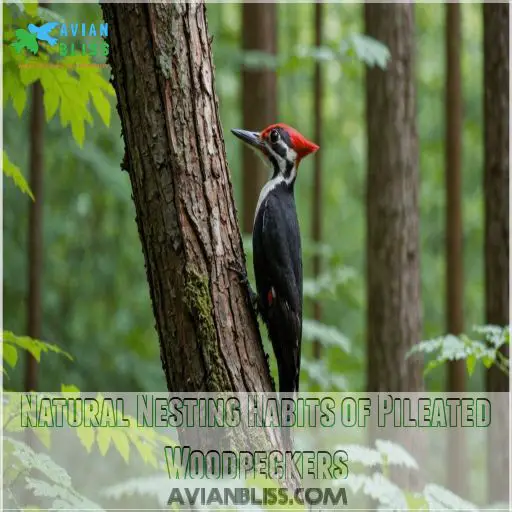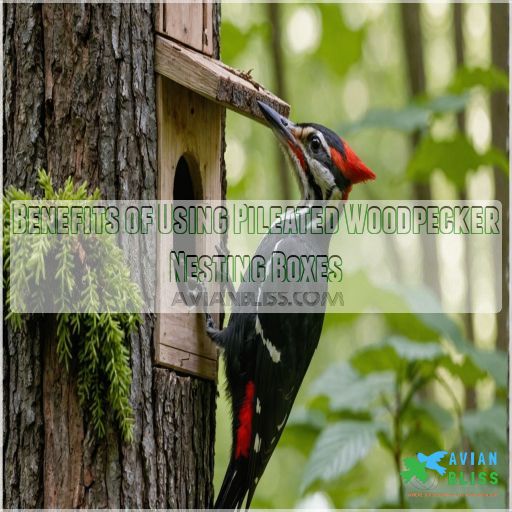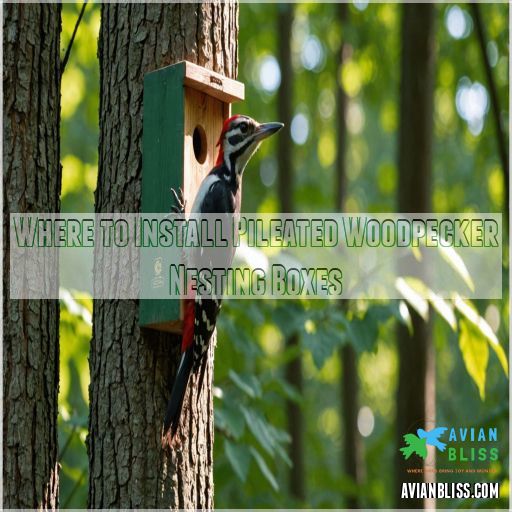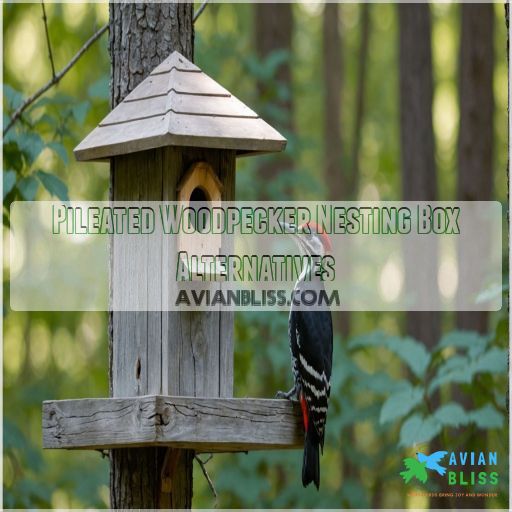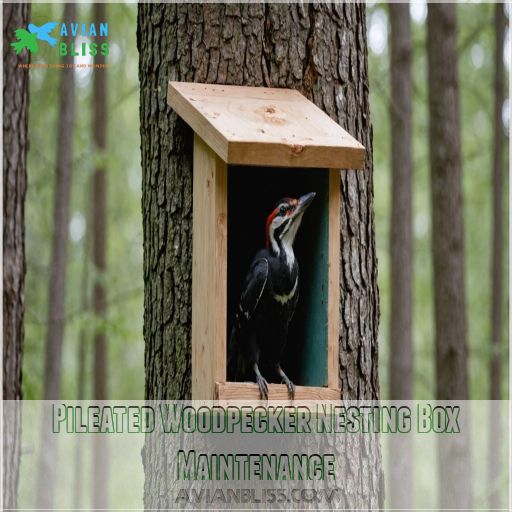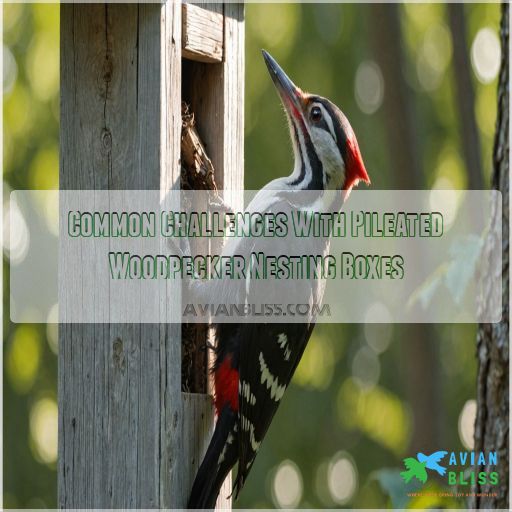This site is supported by our readers. We may earn a commission, at no cost to you, if you purchase through links.

Designing and maintaining these boxes requires specific dimensions and materials, like cedar or pine, and should be placed in serene, high-up spots away from human disruption.
Though they’re a rarity to nest in, boxes can offer supplementary habitat and play a role in conservation.
Want to attract these elusive birds and support biodiversity? There’s a little art and a lot of science involved!
Table Of Contents
- Key Takeaways
- Pileated Woodpecker Nesting Boxes
- When to Install Pileated Woodpecker Nesting Boxes
- Natural Nesting Habits of Pileated Woodpeckers
- Benefits of Using Pileated Woodpecker Nesting Boxes
- Where to Install Pileated Woodpecker Nesting Boxes
- Pileated Woodpecker Nesting Box Alternatives
- Pileated Woodpecker Nesting Box Maintenance
- Effectiveness of Pileated Woodpecker Nesting Boxes
- Common Challenges With Pileated Woodpecker Nesting Boxes
- Conservation Impact of Pileated Woodpecker Nesting Boxes
- Frequently Asked Questions (FAQs)
- Do pileated woodpeckers build their own nest?
- Does a Pileated Woodpecker use a nest box?
- Do pileated woodpeckers roost in the same cavity?
- Where do pileated woodpeckers nest?
- How long do baby pileated woodpeckers stay in the nest?
- Do pileated woodpeckers return to the same nest?
- Does the male or female pileated woodpecker build the nest?
- Where to put a woodpecker nest box?
- Can a nesting box attract multiple woodpecker species?
- How does sawdust impact nest excavation behavior?
- Do pileated woodpeckers reuse nesting boxes annually?
- How does nesting box placement affect territorial disputes?
- What role does diet play in nesting success?
- Conclusion
Key Takeaways
- You might think nesting boxes are like cozy condos for pileated woodpeckers, but they usually prefer constructing their own tree homes. However, these boxes can help support their habitat when natural cavities are scarce, giving them an extra option for housing.
- Building the perfect woodpecker nesting box takes some DIY flair. Use cedar or pine wood for the rough surfaces they can grip, and aim to mount it 20 feet high in a quiet, forested area. It’s like offering them a penthouse suite with a great view.
- Timing is everything—install boxes before spring to get ahead of the rush for natural cavities. Imagine these boxes as VIP backstage passes, enticing woodpeckers early so they don’t miss out on the nesting season.
- While maintaining your woodpecker box, be ready for unexpected guests like squirrels or screech owls, and schedule routine cleanings. Think of it as issuing an eviction notice to pests and providing an eco-friendly Airbnb for our feathered friends.
Pileated Woodpecker Nesting Boxes
If you’re keen on helping Pileated Woodpeckers, nesting boxes can be a great way to supplement their natural habitats and support conservation efforts.
Just like trying to fit into last year’s jeans, getting the size and placement right is key, so let’s explore these basics.
Design and Placement Considerations
Designing a Pileated Woodpecker nesting box involves creativity balanced with practicality. These birds love taller installations, about 20 feet high, often favoring mature forests rich in dead trees.
Choose rough-cut cedar or pine for great grip . This material selection is crucial for the birds.
For placement, think like a bird – high, hidden, and serene, ensuring minimal human disruption while blending beautifully with nature’s decor.
Size and Entrance Requirements
Imagining your pileated woodpecker house like an avian palace? Focus on ideal nest box dimensions:
- Floor: 10 by 10 inches, offering ample nesting space that allows for efficient foraging and energy conservation strategies, such as exploiting wood anatomy to make straight cuts across the grain for efficient chip removal wood pecking strategies.
- Cavity Depth: Approximately 24 inches.
- Entrance Size: A snug 4-inch hole, which is perfect for woodpeckers’ needs, considering their preference for trees with softer wood, such as aspen or birch.
This avian architecture makes sure comfort with a hole shape perfect for woodpeckers’ needs. It’s nesting space they’ll love!
Materials and Installation
When building a pileated woodpecker nesting box, opt for cedar, pine, or other softwoods with rough-cut surfaces to aid grip.
Construct a 10×10-inch floor and 24-inch height, with a 4-inch entrance hole 21 inches above the floor. Drill ventilation openings and stagger mounting holes to prevent splitting.
Proper installation is key – mount the box 20 feet high or more on a suitable tree.
| Wood Type | Floor Size | Entrance | Mounting Height |
|---|---|---|---|
| Cedar, Pine, Softwood | 10×10 inches | 4 inches | 20+ feet |
Maintenance and Upkeep
To maintain your pileated woodpecker nesting box, start by cleaning it annually to remove debris and pests like carpenter ants and wood beetles.
Regularly check for damage to make sure it’s safe and make necessary repairs.
Plus, keep an eye out for unexpected tenants like the eastern screech-owl, wood duck, or even the busy eastern bluebird (Source).
When to Install Pileated Woodpecker Nesting Boxes
If you’re planning to help pileated woodpeckers with nesting boxes, timing is key—install them before the spring nesting season begins.
With competition for natural cavities fierce and suitable trees sometimes scarce, getting those boxes up early can make all the difference for these feathered architects, in providing them with alternative nesting options during a time when natural options are in short supply.
Spring Nesting Season
Now’s the time to think about those pileated woodpecker nesting boxes!
Install them well before spring nesting season begins to make sure nesting success.
These majestic birds, sometimes threatened by human development, appreciate a ready-made home for egg incubation and nestling growth.
Think of it as providing VIP accommodations for this unique species and boosting your backyard’s biodiversity.
Availability of Suitable Trees
Spring’s budding promise is your cue for nesting box installation—but don’t bark up the wrong tree. Healthy, mature woodpecker habitats are goldmines of natural habitats, yet habitat loss and deadwood removal threaten tree species
. Just like great horned owl nesting, which often involves taking over existing nests, preserving old-growth and second-growth woods can provide essential nesting sites for various bird species. Remember the rule of "three": 1. Preserve old-growth and second-growth woods.
- Make sure deciduous forests thrive.
- Support insect populations for vibrant ecosystems.
Competition for Natural Cavities
Imagine you’re a pileated woodpecker in a shrinking forest ecosystem, facing cavities scarcer than a needle in a haystack.
Habitat loss and owl rivalry are real challenges, with natural cavities disappearing faster than popcorn at a movie night.
Tree decay is limited, and predator pressure from pine martens and predatory cats intensifies the competition for these invaluable homes.
Natural Nesting Habits of Pileated Woodpeckers
In terms of their natural nesting habits, Pileated Woodpeckers are master carpenters, crafting impressive cavities in decaying trees as though they were building custom mansions.
Don’t be surprised if you hear their distinct drumming sound echoing through the woods—it’s their version of a construction site!
Tree Selection and Cavity Creation
Pileated woodpeckers are masters of their craft, selecting the perfect trees to carve out their spacious cavities.
They seek out large, decaying trees – often oaks, maples, and elms – with a diameter of 12 to 40 inches.
Their powerful beaks can excavate a cavity in just a few weeks, creating a cozy home for their family.
Nesting Site Preferences
While picking the perfect tree, focus on height and cavity size. Mature forests with large, dead trees offer ideal nesting sites.
The right spot balances safety from predators with access to food, reducing competition.
Keep in mind, climate change may impact these preferences.
Remember, early summer can be prime time for choosing, thanks to active neck muscles and quick reflexes.
Excavation and Construction Process
In selecting the perfect nest location, these woodpeckers exhibit savvy survival strategies. Clearing wood with their beaks, the construction stages unfold like a hidden workshop, taking 3-6 weeks.
- Cavity size matters, as it provides comfort.
- Woodpecker tools involve expert bills and keen instincts.
- Time commitment is essential, often at dawn.
- Community initiatives support nesting success.
Benefits of Using Pileated Woodpecker Nesting Boxes
You might think of nesting boxes as just birdhouses, but for Pileated Woodpeckers, they’re much more—these boxes actually help fill the gap when natural tree cavities are scarce.
By setting up a nesting box, you’re giving these amazing birds a place to crash, but you’re also doing your part to reduce their rent competition and boost conservation efforts.
Supplementing Natural Habitats
Woodpeckers are nature’s little architects, and understanding their nesting habits is enlightening.
These boxes aid conservation efforts by supporting social dynamics and species survival, impacting the environment uniquely, especially in woodpecker nesting sites, like in North Carolina woodpeckers, which can be crucial for the ecosystem
.
Like lending them a helping malar stripe , adding nesting boxes creates artificial cavities that well, let’s say they consider prime real estate.
Reducing Competition for Cavities
Imagine how crowded a forest can become as species compete for natural cavities.
Often, pileated woodpecker nesting boxes can lighten this load! By supplementing natural habitats, they’re like little apartment complexes bringing peace to the neighborhood.
Thoughtful nesting box placement can help alleviate competition, addressing issues of habitat fragmentation and natural cavity decline.
Supporting Conservation Efforts
Think of pileated woodpecker nesting boxes as tiny forest architects. By giving these birds safe nesting spots, you’re fighting habitat loss and boosting biodiversity. Imagine a bustling community of creatures benefiting from this effort!
Here’s how you can help:
- Set up and monitor nest boxes.
- Join citizen science projects.
- Support forest restoration.
- Track population trends.
Where to Install Pileated Woodpecker Nesting Boxes
Choosing the right location is key when installing pileated woodpecker nesting boxes.
You’ll want to target forested areas, woodlands, or even your own backyard – just make sure there’s plenty of food nearby.
Forested Areas and Woodlands
In mature forests, Pileated Woodpecker boxes boost forest health by countering habitat loss and supporting tree diversity, which is crucial for their nesting and breeding. Pileated Woodpecker habitat preferences
. Choosing the right spot enhances wildlife management. Install boxes amid tree diversity to combat invasive species.
| Installation Tips | Placement Considerations | Benefits |
|---|---|---|
| Interior of forest | 330 feet apart | Supports biodiversity |
| High trees | Face southeast | Less predator risk |
| Fill with sawdust | Avoid cedar filling | Encourages nesting |
Consider these tips, and provide a cozy home for these striking birds.
Backyards and Residential Areas
While forested areas are prime, consider your backyard for pileated woodpecker nesting boxes. A dash of habitat magic can attract these feathered giants.
Keep dead trees, if safe, to enhance natural charm (Source). This can create a favorable environment for the woodpeckers.
Although cautious, woodpeckers may warm up over time, especially if you respect their space. It’s like offering a VIP woodland suite in your own backyard.
Proximity to Food Sources
Place your pileated woodpecker nesting box near abundant food sources.
These birds are particularly fond of carpenter ants and other insects.
Locating the box where there’s a banquet of bugs is key, as foraging preferences guide them to places rich in ants and beetle larvae, making your nest box placement all the more appealing.
Pileated Woodpecker Nesting Box Alternatives
If you’re thinking about creating a perfect home for Pileated Woodpeckers, consider alternatives to traditional nesting boxes.
Like leaving dead trees and logs or making artificial cavities, these alternatives can be more appealing.
Nature’s architects sometimes prefer these options, as each treehole renovation comes with its own charm!
Using Dead Trees and Logs
Dead trees and logs are like nature’s skyscrapers for Pileated Woodpeckers. They’re the ideal habitat, bustling with life.
- Insects that serve as a tasty buffet
- Decay creating the perfect softwood
- Cavities ready for nesting
- Deadwood offering safety from predators
- Nurtured ecosystems that sustain diverse wildlife
So, leave deadwood standing; it’s a natural wonder.
Creating Artificial Cavities
Creating artificial cavities can give pileated woodpeckers a helping hand when natural options are scarce.
It’s like offering them a custom-made tree hotel! Use suitable materials like cedar or pine and make sure the cavity size fits their needs.
Place it high up, around 20 feet, for the best placement strategy. A little DIY spirit goes a long way! .
Other Nesting Options
Rather than installing a nesting box, consider using dead trees or logs on your property to provide natural cavities for pileated woodpeckers.
These birds prefer to excavate their own homes in decaying wood, which also benefits other cavity-nesting species.
You can even create artificial cavities by drilling holes in trees . Explore the variety of nesting options to best support these magnificent birds.
Pileated Woodpecker Nesting Box Maintenance
Taking care of Pileated Woodpecker nesting boxes is like minding a luxury treehouse — they need regular cleaning, occasional repairs, and pest monitoring to stay in top shape.
If you spot any uninvited guests or weather damage, it’s time to step in and spruce things up!
Cleaning and Disinfecting
When maintaining pileated woodpecker nesting boxes, cleaning frequency matters.
Once brood season’s over, remove old debris to make sure long-term hygiene . Choose mild disinfectant options like diluted bleach, but never use harsh chemicals.
Safety precautions are crucial when caring for these birds. Gloves and masks are must-haves to prevent messing up your health while caring for theirs. This is essential to ensure a safe and healthy environment for both you and the woodpeckers.
Keeping boxes tidy makes sure these feathered friends return year after year.
Repairing and Replacing
Keeping your Pileated Woodpecker nesting box in tip-top shape is a breeze! Don’t let woodpecker damage stress you out.
Tackle repairs using:
- Spray foam insulation to fill any holes.
- Wood glue for reattaching loose parts.
- Metal portals to protect entrance holes.
These DIY solutions help keep the box in good shape while keeping critters comfy.
Monitoring for Pests and Predators
Amidst monitoring your pileated woodpecker nesting box, remember that nest box security is super important.
Regular checks—a birdwatcher’s routine!—and natural defenses like planting thick shrubs deter raccoon raids.
For pest control, keep an eye out for ants and bees.
With predator deterrence, a baffle can block snakes and squirrels, securing the site while you savor nature’s drama.
Effectiveness of Pileated Woodpecker Nesting Boxes
You might think installing a woodpecker nesting box is a simple fix, but without the right conditions, it’s like offering a five-star restaurant to a bird that’s already full.
Understanding the effectiveness of these boxes requires considering research and best practices, ensuring these winged architects have a suitable habitat to call home, which relates to the idea of providing a suitable habitat to call home.
Research and Studies
Understanding the effectiveness of pileated woodpecker nesting boxes can feel like finding a hidden treasure.
While formal research remains limited, anecdotal evidence suggests these boxes really do support woodpecker populations.
Proper box design impacts woodpecker behavior, enabling easier nesting and enhancing conservation success.
Imagine boxes as cozy cabins, inviting woodpeckers to settle down and thrive, positively influencing their population dynamics and contributing to ecosystems’ health.
Lessons Learned and Best Practices
Two key lessons stand out:
Placement is paramount – position boxes in mature forests near food sources for best results.
And regular monitoring is a must – check for pests, predators, and needed repairs to make sure your boxes remain safe havens for these magnificent birds.
With a little diligence, you can create the perfect pileated pad!
Common Challenges With Pileated Woodpecker Nesting Boxes
Installing nesting boxes for Pileated Woodpeckers is a bit like playing landlord for picky tenants—they may attract other species who crash the party or lure in predators hoping for an easy meal.
To keep things running smoothly, you’ll need to be prepared for regular maintenance and occasional surprises!
Attracting Other Species
While nesting boxes for Pileated Woodpeckers might invite other birds like owls and ducks, this species diversity can be a delightful surprise.
Nesting competition leads to cavity sharing, allowing other birds a cozy home.
This habitat overlap also boosts interdependence benefits, creating a lively avian neighborhood.
Remember, life’s more fun when you’ve got diverse feathered friends.
Predator Attraction
Watch out for potential predators when choosing where you put your Pileated Woodpecker nesting boxes!
Raccoons and squirrels, for instance, might consider these boxes the perfect buffet.
Placing boxes high in trees or using predator guards can help.
Nature’s built-in security systems, like dense branches, also deter unwanted guests.
Remember, your goal is to offer a safe home, not a snack shack!
Maintenance and Upkeep Issues
Let’s face it, nesting boxes aren’t self-cleaning. To make sure nesting box longevity, remember upkeep involves:
- Box cleaning: Remove old nests to prevent pests.
- Material degradation: Check for damage like swelling or wear.
- Pest control: Keep bugs at bay to prevent harm to the inhabitants.
Regular maintenance helps keep woodpeckers happy and nesting! Plus, it’s a small effort for a big impact on conservation.
Conservation Impact of Pileated Woodpecker Nesting Boxes
Did you know Pileated Woodpecker nesting boxes are like cozy homes on the real estate market for birds?
By setting these up, you’re helping preserve forest ecosystems while promoting biodiversity—just make sure they meet the woodpeckers’ high architectural standards!
Supporting Pileated Woodpecker Populations
Pileated woodpecker nesting boxes can be a game-changer for supporting their populations.
By providing safe, suitable cavities, you’re giving these magnificent birds a much-needed boost. Their impressive excavation skills are preserved, and their important role in forest ecosystems is reinforced (Source).
It’s a simple yet impactful way to lend a helping hand, and these nesting boxes are a game-changer for the birds.
Preserving Forest Ecosystems
Crafting nesting boxes for woodpeckers can greatly enhance forest health by addressing habitat fragmentation and encouraging sustainable forestry.
Follow these steps:
- Create sturdy wildlife corridors to connect forest patches.
- Position boxes near food sources, considering climate change implications.
- Make sure trees have protective canopy cover.
- Regularly monitor boxes for wear and predator access to keep ecosystems thriving.
Promoting Biodiversity and Conservation
While supporting forest ecosystems, nesting boxes also boost biodiversity and conservation by fostering collaboration.
| Aspect | Impact | Goal |
|---|---|---|
| Habitat Restoration | Enhances living spaces | Support Diverse Species |
| Forest Management | Balances ecological needs | Promote Species Survival |
| Species Monitoring | Tracks woodpecker populations | Inform Conservation Plans |
| Citizen Science | Engages local communities | Empower Conservationists |
It’s a team effort!
Frequently Asked Questions (FAQs)
Do pileated woodpeckers build their own nest?
Did you know these woodpeckers spend 3-6 weeks crafting nest cavities?
They choose dead or decaying trees for nesting, diligently excavating their homes themselves.
They add a personal touch—only leftover wood chips as decoration.
Does a Pileated Woodpecker use a nest box?
It’s unlikely a Pileated Woodpecker will use a nest box, as they prefer excavating their own cavities in dead trees.
However, offering a nest box might attract other birds like screech owls or kestrels instead.
Do pileated woodpeckers roost in the same cavity?
Pileated woodpeckers don’t typically roost in the same cavity year-round.
They excavate a new nest cavity each breeding season, though they may reuse a cavity from a previous year.
These birds are known to roost individually in tree cavities.
They are also known for excavate a new nest cavity each breeding season.
Where do pileated woodpeckers nest?
You’ll find these striking woodpeckers nesting in dense, mature forests.
They prefer to hollow out cavities in dead or decaying trees, high above the ground, for their nests—a real fixer-upper challenge.
How long do baby pileated woodpeckers stay in the nest?
Young pileated woodpeckers, those delightful fluff balls, typically hang out in the nest for about 24 to 31 days, enjoying the cozy digs before venturing into the wild world with a newly earned badge of independence.
Do pileated woodpeckers return to the same nest?
They’re not fond of returning to old neighborhoods; pileated woodpeckers rarely reuse their nests.
Each year, they prefer excavating fresh holes, leaving their previous homes open for others like honeybees or squirrels to move in.
Does the male or female pileated woodpecker build the nest?
The male pileated woodpecker takes the lead in nest building.
The male does most of the excavation work. But just like a construction supervisor, the female steps in, helping to complete and perfect the nest cavity.
Where to put a woodpecker nest box?
Place a woodpecker nest box in a mature hardwood forest or on a dead tree.
Make sure to space them at least 330 feet apart.
Face them northeast, southeast, southwest, east, or south for best results.
Can a nesting box attract multiple woodpecker species?
Imagine a woodpecker condo.
Different species can nest in the same box, but it’s a bit of a woodpecker standoff.
Larger woodpeckers might evict smaller ones, making it a cozy yet competitive haven.
How does sawdust impact nest excavation behavior?
Woodpeckers expertly excavate their nests, flicking out sawdust to create the perfect cavity. The process takes time and effort, but their diligence guarantees a cozy, secure home for their young.
Do pileated woodpeckers reuse nesting boxes annually?
Expecting pileated woodpeckers to reuse a nesting box is like hoping for lightning to strike twice.
They rarely reuse their own nests, preferring new sites each year, making it unlikely they’ll return to the same box.
How does nesting box placement affect territorial disputes?
When placing nesting boxes for pileated woodpeckers, consider spacing them far enough apart to avoid territorial disputes.
Ensuring each box is isolated reduces competition, giving these majestic birds plenty of room to claim their space peacefully.
This ensures that the birds can live in harmony with one another.
What role does diet play in nesting success?
Think of a woodpecker’s diet like your favorite power bar; it fuels nesting success.
A varied diet rich in ants and insects provides essential nutrients for energy, aiding in reproduction and chick development.
Ensuring healthier offspring is also a result of this diet.
Conclusion
Imagine you’re crafting a sanctuary, a castle for the knights of the forest—the pileated woodpeckers. Understanding the truth about pileated woodpecker nesting boxes means recognizing their potential role in conservation while respecting the birds’ natural preferences.
By thoughtfully designing, placing, and maintaining these boxes, you can boost their habitat diversity. It’s like adding extra rooms to a house, making life a tad more comfortable and while supporting biodiversity in your backyard kingdom.

